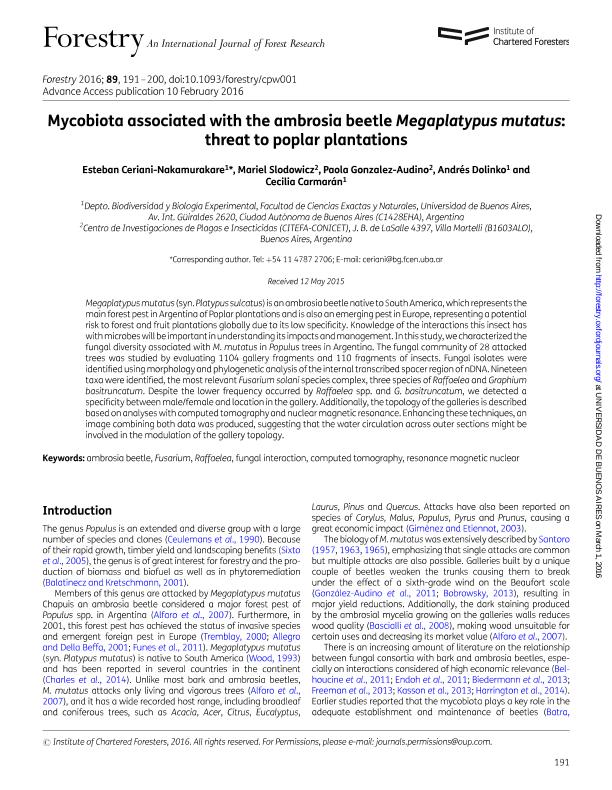Artículo
Mycobiota associated with the ambrosia beetle Megaplatypus mutatus: Threat to poplar plantations
Ceriani Nakamurakare, Esteban Daniel ; Slodowicz, Mariel Pamela
; Slodowicz, Mariel Pamela ; Gonzalez Audino, Paola Andrea
; Gonzalez Audino, Paola Andrea ; Dolinko, Andrés Ezequiel
; Dolinko, Andrés Ezequiel ; Carmaran, Cecilia Cristina
; Carmaran, Cecilia Cristina
 ; Slodowicz, Mariel Pamela
; Slodowicz, Mariel Pamela ; Gonzalez Audino, Paola Andrea
; Gonzalez Audino, Paola Andrea ; Dolinko, Andrés Ezequiel
; Dolinko, Andrés Ezequiel ; Carmaran, Cecilia Cristina
; Carmaran, Cecilia Cristina
Fecha de publicación:
04/2016
Editorial:
Oxford University Press
Revista:
Forestry
ISSN:
0015-752X
Idioma:
Inglés
Tipo de recurso:
Artículo publicado
Clasificación temática:
Resumen
Megaplatypus mutatus (syn. Platypus sulcatus) is an ambrosia beetle native to South America, which represents the main forest pest in Argentina of Poplar plantations and is also an emerging pest in Europe, representing a potential risk to forest and fruit plantations globally due to its low specificity. Knowledge of the interactions this insect has with microbes will be important in understanding its impacts and management. In this study, we characterized the fungal diversity associated with M. mutatus in Populus trees in Argentina. The fungal community of 28 attacked trees was studied by evaluating 1104 gallery fragments and 110 fragments of insects. Fungal isolates were identified using morphology and phylogenetic analysis of the internal transcribed spacer region of nDNA. Nineteen taxa were identified, the most relevant Fusarium solani species complex, three species of Raffaelea and Graphium basitruncatum. Despite the lower frequency occurred by Raffaelea spp. and G. basitruncatum, we detected a specificity between male/female and location in the gallery. Additionally, the topology of the galleries is described based on analyses with computed tomography and nuclear magnetic resonance. Enhancing these techniques, an image combining both data was produced, suggesting that the water circulation across outer sections might be involved in the modulation of the gallery topology.
Archivos asociados
Licencia
Identificadores
Colecciones
Articulos(OCA CIUDAD UNIVERSITARIA)
Articulos de OFICINA DE COORDINACION ADMINISTRATIVA CIUDAD UNIVERSITARIA
Articulos de OFICINA DE COORDINACION ADMINISTRATIVA CIUDAD UNIVERSITARIA
Articulos(UNIDEF)
Articulos de UNIDAD DE INVESTIGACION Y DESARROLLO ESTRATEGICOS PARA LA DEFENSA
Articulos de UNIDAD DE INVESTIGACION Y DESARROLLO ESTRATEGICOS PARA LA DEFENSA
Citación
Ceriani Nakamurakare, Esteban Daniel; Slodowicz, Mariel Pamela; Gonzalez Audino, Paola Andrea; Dolinko, Andrés Ezequiel; Carmaran, Cecilia Cristina; Mycobiota associated with the ambrosia beetle Megaplatypus mutatus: Threat to poplar plantations; Oxford University Press; Forestry; 89; 2; 4-2016; 191-200
Compartir
Altmétricas



